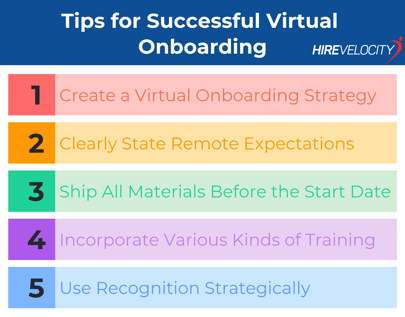
What does it take to hire quality workers without any in-person interaction?
Hiring top talent remotely is no longer a short-term solution—it’s a long-term strategy. While many companies have shifted to hybrid or in-office models, remote hiring remains essential for accessing a broader talent pool and maintaining agility in today’s workforce. At Hire Velocity, we help clients streamline the remote hiring process—from sourcing and screening to virtual interviewing and onboarding. Here’s how to make your remote hiring strategy effective, engaging, and scalable.
Remote work has evolved significantly over the past few years. While some companies are returning to in-office or hybrid models, others continue to rely on remote teams to access top talent and meet evolving workforce demands.
They have also had to adapt standard hiring processes in light of stay-at-home protocols as they consider how to support talent demands both now and in the future.
At Hire Velocity, we routinely assist our clients with hiring quality talent in a remote environment, and we’ve pulled together our best recommendations for sourcing, screening, hiring, and onboarding in a virtual environment. With the right technology and some adjustments to your strategic process, remote hiring is not only possible, but it can be just as effective.
As you consider each category, evaluate your current processes in that area to see what can be carried over for remote candidates and what needs to be revamped.
Sourcing
Many of your sourcing strategies are probably already handled without any in-person interaction. You may already post on job boards, maintain a career page on your website, and advertise jobs on LinkedIn and other social platforms. If you don’t, these are good places to start.
In addition to these activities, however, here are a few more ways to extend your reach:
- Mobile Job Site and Application – Almost half of job seekers are more likely to search for jobs on a mobile device than on a desktop. You can best reach these candidates by optimizing your job site and application process for mobile. In addition, include language on your job page that lets candidates know how you handle the remote interviewing and hiring process.
- Conduct a Virtual Job Fair – If you rely on job fairs to find candidates, you’ll need to find creative ways to reach those same people in a virtual environment. One way to do that is to host a virtual job fair using a technology platform like Brazen. With a virtual job fair, you can do video presentations to showcase your company, and you can also schedule one-on-one chats with candidates.
Screening
Like sourcing, much of the screening process already takes place at a distance. You may already use resume-screening software to narrow down your candidate list and identify the most promising talent. Once you have your shortlist, however, you will need to conduct more detailed candidate screenings in a remote environment. There are several tools on the market that can help you with this process:
- Online assessments – Candidate assessments give you insight into a person’s personality, motivations, problem-solving skills, leadership skills, technical aptitude, skills proficiency, and other key qualities. Most of these assessments can be conducted online, and advancements in AI have made it possible to automate much of the process while also removing bias.
- Chatbots – Recruiting chatbots can help you early in the screening process by gathering information from candidates about skills, qualifications, and credentials. They also help candidates feel more engaged with the process, answer common questions that applicants may have, and improve the overall candidate experience.
- Applicant Tracking Systems – You can use tools already available in your ATS to ask assessment questions, search your existing candidate pool, and filter candidates based on skills, credentials, or other criteria. This helps you narrow down your candidate lists in preparation for the interview process. It can also help you find promising candidates who may have applied at an earlier time or who are already working with your company in a different role.
Interviewing
Remote interviews may present the steepest learning curve for hiring managers who are used to engaging with candidates face-to-face during the final interview process. The good news is that video and phone interviews can accomplish many of the same goals you would normally achieve in person. AI-enabled technology can reduce bias by assessing candidates facial expressions and body language. Prepare your hiring managers to conduct successful virtual interviews with virtual training on techniques and best practices for the format. You can also help candidates prepare for video interviews by including a list of video interviewing tips in their candidate information.
Hiring
Once you have made the final decision on which candidate(s) will receive an offer, you may need to adjust some of your hiring procedures to be conducted online rather than in person. For example:
- Legal Documents – Know what is absolutely required from a legal standpoint in terms of signatures and witnesses, and find ways to accomplish that virtually. Electronic signatures are fairly standard, but you may need to get creative for documents that require a witness. For example, you may be able to ask a family member of the new hire to act as a witness, or you may be able to witness the signature over Zoom. Know what is required in your state so you can be sure to meet all compliance guidelines.
- Background Checks – Talk with your background check vendor to determine what they can do virtually and which parts of the process are required in your state.
Onboarding
In addition to giving new hires information about their role, signing paperwork, and getting them settled in, the onboarding process is your chance to sell new employees on your company. That should still be a primary goal, even when you move onboarding online. Your virtual onboarding strategy should still include mentoring, recognition, and connection with other team members, even if it is all done over Zoom or Microsoft Teams.
Here are some tips on navigating this process successfully:

- Create a Virtual Onboarding Strategy – Don’t just shoehorn remote candidates into your standard onboarding process. Look for ways that you can adapt every element to a remote environment so that new hires still feel valued and engaged.
- Clearly State Remote Expectations – How will you track time? Will attendance at virtual meetings be expected? Should candidates be on the clock from 9:00 to 5:00, or is there flexibility in the schedule? Develop a comprehensive remote workforce strategy and policy to make sure all remote employees understand your expectations for productivity, accessibility, and team interactions.
- Ship All Materials Before the Start Date – Be sure remote employees have all technology, hardware, materials, logins, and anything else they need to hit the ground running on Day One.
- Incorporate Various Kinds of Training – Use your online learning library for virtual training, but don’t neglect live interactions with team members, managers, and mentors via Zoom or Teams. You can also use microlearning materials to help new employees with in-the-moment learning (for example, a list of customer service steps for a remote call center worker).
- Use Recognition Strategically – Don’t leave remote employees out of your recognition strategy. Recognition during onboarding is an effective way to promote engagement with your team and cement a positive relationship. Incorporate a welcome video from the CEO into your onboarding process, and make time for real conversations with managers to answer questions and provide feedback.
Remote hiring isn’t just about adapting to change—it’s about building a talent strategy that scales. Whether your team is fully remote or hybrid, having a clear, consistent process helps attract top candidates, reduce friction, and improve retention.
Need help building or optimizing your remote hiring process? Contact Hire Velocity to create a sourcing, screening, and onboarding strategy that supports your long-term hiring goals.


